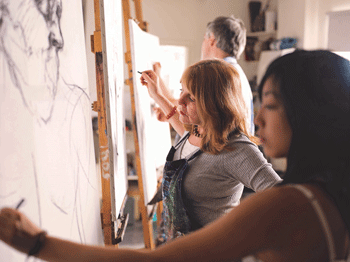 Why does art matter? This is a question that has given philosophers and artists food for thought for centuries.
Why does art matter? This is a question that has given philosophers and artists food for thought for centuries.
It’s also been a leading question in many school districts when budget cuts have forced school administrators to put various curricula on the chopping block. Very often arts programs are the first to be cut.
From their earliest years, many children communicate and learn through artistic expression. Songs help them learn words and repetition to develop speech and reading skills. Drawing, painting and crafting helps to solidify motor skills. Though 88% of Americans consider the arts part of a well-rounded education, an American for the Arts public opinion survey found that the percentage of students receiving arts education has shrunk dramatically over the last few decades.
Houston’s Arts Access Initiative, in conjunction with Houston Education Research Consortiums, found a substantial increase in arts educational experiences had remarkable effects on students’ academic, social and emotional outcomes. Students who participated in arts education experienced a 3.6% reduction in disciplinary infractions, an improvement of 13% of a standard deviation in standardized writing scores, and an increase of 8% of a standard deviation in students’ compassion for others. Compassion translated into wanting to help people who were treated badly and being more conscious of how other people feel.
The Nation’s Report Card, the largest ongoing assessment of what students in the United States know and can do, shows that American students continue to score lower than many of their peers in Europe and Asia. Seeking to improve performance in reading and math may be as simple as including arts education. Researchers from the Johns Hopkins University School of Education say that instruction becomes more effective when educators integrate creative activities.
Encouraging creativity and imagination across all disciplines can help shine light on new concepts and help students discover connections and innovative ideas.
To bolster support of arts in the classroom, parents and educators can point out the following benefits of arts education.
Increases creativity: The arts let students express themselves in different ways and offer outlets for all types of skills.
Improves academic performance: A report by Americans for the Arts indicates young people who regularly participate in the arts are four times more likely to be recognized for academic achievement than non-participants.
Develops motor skills: Arts helps foster motor skills, which are essential for writing letters and words, playing musical instruments, using paintbrushes, and much more.
Helps one appreciate numeracy: Art involves patterns and problem solving. Learning these skills translates into many different disciplines, including mathematics.
May accelerate brain development: Bright Horizons, a U.S.-based child care provider, reports learning to play an instrument has been found to improve mathematical learning, boost memory and lead to improved academic scores.
The benefits of arts in the classroom cannot be ignored. The arts encourage students to use many skills that translate to various subjects.

 How to resolve AdBlock issue?
How to resolve AdBlock issue? 








